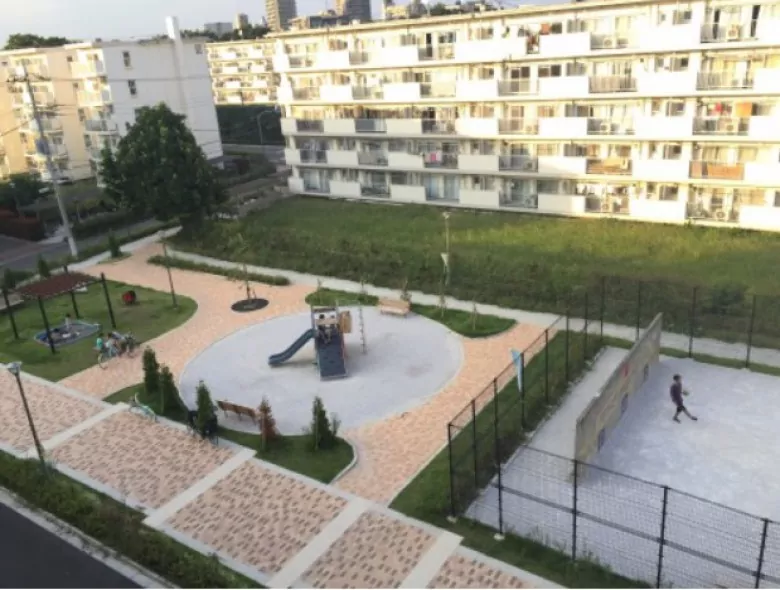In a country where old buildings are frequently torn down, it may be surprising to hear that renovating old apartment complexes is gaining popularity. Danchi renovation shows that old buildings can be revitalized into amazing homes.
While the word “danchi” often brings to mind poverty and old buildings, recent revitalization projects have been working to improve their image. With trendy brands like Muji bringing minimalism and other popular interior design styles to danchi, the large apartment complexes are starting to regain their once modern reputation. Curious about the potential that these old, once loved, now stigmatized buildings hold? Read on to learn more about danchi renovation.

What are Danchi?
Danchi are large clusters of apartment buildings. They were usually created by the government to serve as public housing, but some companies built danchi for their employees to live in. When they were first built throughout the 1950s to 1970s, danchi were seen as modern and convenient. Most danchi are located near public transportation and stores.
Metropolitan areas like Tokyo and Osaka have more danchi than rural Japan. Living in one is much more affordable than renting a “mansion” (condo/upper-scale apartment) or paying a mortgage. However, danchi today are rapidly aging and suffering from an image problem. Since many danchi were built years ago, they are now considered outdated and have accessibility issues. While they were once associated with a new and innovative way of living, danchi have come to be associated with poverty, elderly people, and outdated buildings.

Making Danchi Cool Again
Several real estate agencies that were tasked with building danchi in the past are now partnering with modern lifestyle brands to renovate these large apartment complexes. Brands such as Muji and their fashionable aesthetics have helped boost the image of renovated danchi. These danchi apartments renovated in collaboration with Muji have sleek and open minimalist designs.
Danchi renovated by Muji aren’t the only apartment complexes gaining popularity. A danchi renovation project in Yokohama is doing more than sprucing up old apartments; it’s also working to revitalize the local community. When Yokodai Danchi was renovated, a space known as Community Challenge Lab was made out of vacant store space in front of the apartment complex. The Community Challenge Lab is used to host a variety of activities, such as exercise classes, cafes, and art exhibitions. The Halloween event held there is so popular that it attracts over 3,000 people each year.
Another danchi in Yokohama, Tama Plaza Danchi, was renovated by Aidaho, a stylish boutique architecture firm. By taking on a danchi renovation project, Aidaho helped demonstrate the potential that lies in renovating old buildings. Village House has also renovated Danchi, paying attention to both the interior and exterior of old apartment complexes. In particular, the outside walls are painted a more modern color, making them a more attractive place to live.

Renovating Danchi
When renovating danchi, collaborating agencies and brands try to retain as many existing components of the building as possible. Muji often demolishes walls and other unnecessary parts of an apartment, leaving behind the original pillars. This allows them to turn an apartment with a few small rooms into a large, open-space studio. They add shelves, light fixtures, and other details to create a modern aesthetic.
Muji has also improved upon tatami and installed a new type of flooring in their renovated danchi. Tatami is useful because it can be used for many things – exercising, sleeping on, sitting on, and more. However, tatami does not match modern interior design aesthetics, so it is becoming unpopular. Muji created tatami-like flooring out of linen, which better matches their minimalist look and feels nicer against the skin.
Renovated danchi are also made to be more accessible and functional. Old danchi are typically poorly insulated and hard to keep warm in the winter. When they are renovated, features like bathroom heaters and flooring that is resistant to cold are put in. Intercom systems with monitors are also installed, and the lighting and color scheme of renovated danchi are designed to prevent tripping and falling. In addition, old doorknobs are replaced with lever handles, and handrails are installed in the bathroom and toilet. These features make it easier for older people and people with disabilities to live in danchi. At Village House, there are a variety of units with different levels of accessibility inside the same renovated complex. This means that tenants with diverse lifestyles have many options to choose from.

Convenient, Modern, and Affordable
Renovating danchi have once again made them convenient, modern, and affordable places to live. Since they were originally built close to public transportation and stores, danchi living allows for a convenient urban lifestyle. Danchi that are meant to revitalize the community offer residents ways to make friends and have fun. Although renovating danchi can be costly, living in one is still much more affordable than living in a new “mansion”. In Japan, it’s fairly common for old buildings to simply be torn down and rebuilt. Danchi renovation shows that with some creativity and care, there’s still a lot of potential in old apartment complexes.
Danchi Renovation Picture Gallery
Here you can see the drastic difference that danchi renovation practices have on bringing new life into old danchi housing in Japan and modernizing them.









